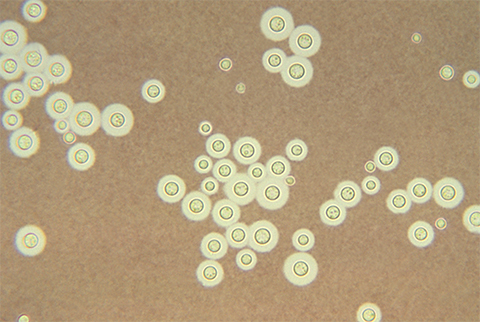Warmer climate may drive fungi to be more dangerous to our health
The world is filled with tiny creatures that find us delicious. Bacteria and viruses are the obvious bad guys, drivers of deadly global pandemics and annoying infections. But the pathogens we haven’t had to reckon with as much – yet – are the fungi.
Pathogenic fungi (Candida, Aspergillus, Cryptococcus and others) are notorious killers of immune-compromised people. But for the most part, healthy people have not had to worry about them, and the vast majority of the planet’s potentially pathogenic fungi don’t do well in the heat of our bodies.

But all that may be about to change.
A new study out of Duke University School of Medicine finds that raised temperatures cause a pathogenic fungus known as Cryptococcus deneoformans to turn its adaptative responses into overdrive. This increases its number of genetic changes, some of which might presumably lead to higher heat resistance, and others perhaps toward greater disease-causing potential.
Specifically, higher heat makes more of the fungus’ transposable elements, or jumping genes, get up and move around within the fungal DNA, leading to changes in the way its genes are used and regulated. The findings appeared Jan. 20 in the Proceedings of the National Academy of Sciences.
“These mobile elements are likely to contribute to adaptation in the environment and during an infection,” said postdoctoral researcher Asiya Gusa Ph.D. of Molecular Genetics and Microbiology in the Duke School of Medicine. “This could happen even faster because heat stress speeds up the number of mutations occurring.”
This may ring a bell with viewers of the new HBO series “The Last of Us,” where a dystopian hellscape is precipitated by a heat-adapted fungus that takes over humans and turns them into zombies. “That’s exactly the sort of thing I’m talking about -- minus the zombie part!” said Gusa who just watched the first episode and who will join the Duke faculty as an assistant professor later this year.
“These are not infectious diseases in the communicable sense; we don’t transmit fungi to each other,” Gusa said. “But the spores are in the air. We breathe in spores of fungi all the time and our immune systems are equipped to fight them.”
Fungal spores are generally larger than viruses, so your existing stock of face masks against Covid would probably be sufficient to stop them. That, and your body heat, for now.

”Fungal diseases are on the rise, largely because of an increase in the number of people who have weakened immune systems or underlying health conditions,” Gusa said. But at the same time, pathogenic fungi may be adapting to warmer temperatures as well.
Working in the lab of Professor Sue Jinks-Robertson, Gusa led research that focused on three transposable elements that were particularly active under heat stress in C. deneoformans. But there are easily another 25 or more transposable elements in that species that could mobilize, she said.
The team used ‘long-read’ DNA sequencing to see changes that might otherwise have been missed, Gusa said. Computational analysis allowed them to map transposons and then see how they had moved. “We have improved tools now to see these movements that were previously hiding in our blind spots.”
Heat stress sped the mutations up. Following 800 generations of growth in laboratory medium, the rate of transposon mutations was five-times higher in fungi raised at body temperature (37 Celsius) compared with fungi raised at 30C.
One of the transposable elements, called T1, had a tendency to insert itself between coding genes, which could lead to changes in the way genes are controlled. An element called Tcn12 often landed within the sequence of a gene, potentially disrupting that gene’s function and possibly leading to drug resistance. And a third kind, Cnl1, tended to land near or in the telomere sequences at the ends of chromosomes, an effect which Gusa said isn’t fully understood.
The mobilization of transposable elements also appeared to increase more in fungi living in mice than in lab culture. “We saw evidence of all three transposable elements mobilizing in the fungus genome within just ten days of infecting the mouse,” Gusa said. The researchers suspect that the added challenges of surviving in an animal with immune responses and other stressors may drive the transposons to be even more active.
“This is a fascinating study, which shows how increasing global temperature may affect the fungal evolution in unpredictable directions,” said Arturo Casadevall MD, PhD, the chair of molecular microbiology & immunology at Johns Hopkins University. “As the world warms, transposons in soil fungi like Cryptococcus neoformans could become more mobile and increase genomic changes in ways that could enhance virulence and drug resistance. One more thing to worry about with global warming!”
Gusa’s work was helped by collaboration with Duke labs that also study fungi, the Joseph Heitman lab in the school of medicine and the Paul Magwene lab in Trinity Arts & Sciences.
The next phase of this research will be looking at pathogens from human patients who have had a relapsing fungal infection. “We know that these infections can persist and then come back with potential genetic changes.”
It’s time to get serious about pathogenic fungi, Gusa said. “These kinds of stress-stimulated changes may contribute to the evolution of pathogenic traits in fungi both in the environment and during infection. They may be evolving faster than we expected.”
This article first appeared in Duke Today and was republished with permission. Read the original.
Enjoy reading ASBMB Today?
Become a member to receive the print edition four times a year and the digital edition monthly.
Learn moreGet the latest from ASBMB Today
Enter your email address, and we’ll send you a weekly email with recent articles, interviews and more.
Latest in Science
Science highlights or most popular articles

CRISPR epigenome editor offers potential gene therapies
Scientists from the University of California, Berkeley, created a system to modify the methylation patterns in neurons. They presented their findings at ASBMB 2025.

Finding a symphony among complex molecules
MOSAIC scholar Stanna Dorn uses total synthesis to recreate rare bacterial natural products with potential therapeutic applications.

E-cigarettes drive irreversible lung damage via free radicals
E-cigarettes are often thought to be safer because they lack many of the carcinogens found in tobacco cigarettes. However, scientists recently found that exposure to e-cigarette vapor can cause severe, irreversible lung damage.

Using DNA barcodes to capture local biodiversity
Undergraduate at the University of California, Santa Barbara, leads citizen science initiative to engage the public in DNA barcoding to catalog local biodiversity, fostering community involvement in science.

Targeting Toxoplasma parasites and their protein accomplices
Researchers identify that a Toxoplasma gondii enzyme drives parasite's survival. Read more about this recent study from the Journal of Lipid Research.

Scavenger protein receptor aids the transport of lipoproteins
Scientists elucidated how two major splice variants of scavenger receptors affect cellular localization in endothelial cells. Read more about this recent study from the Journal of Lipid Research.

